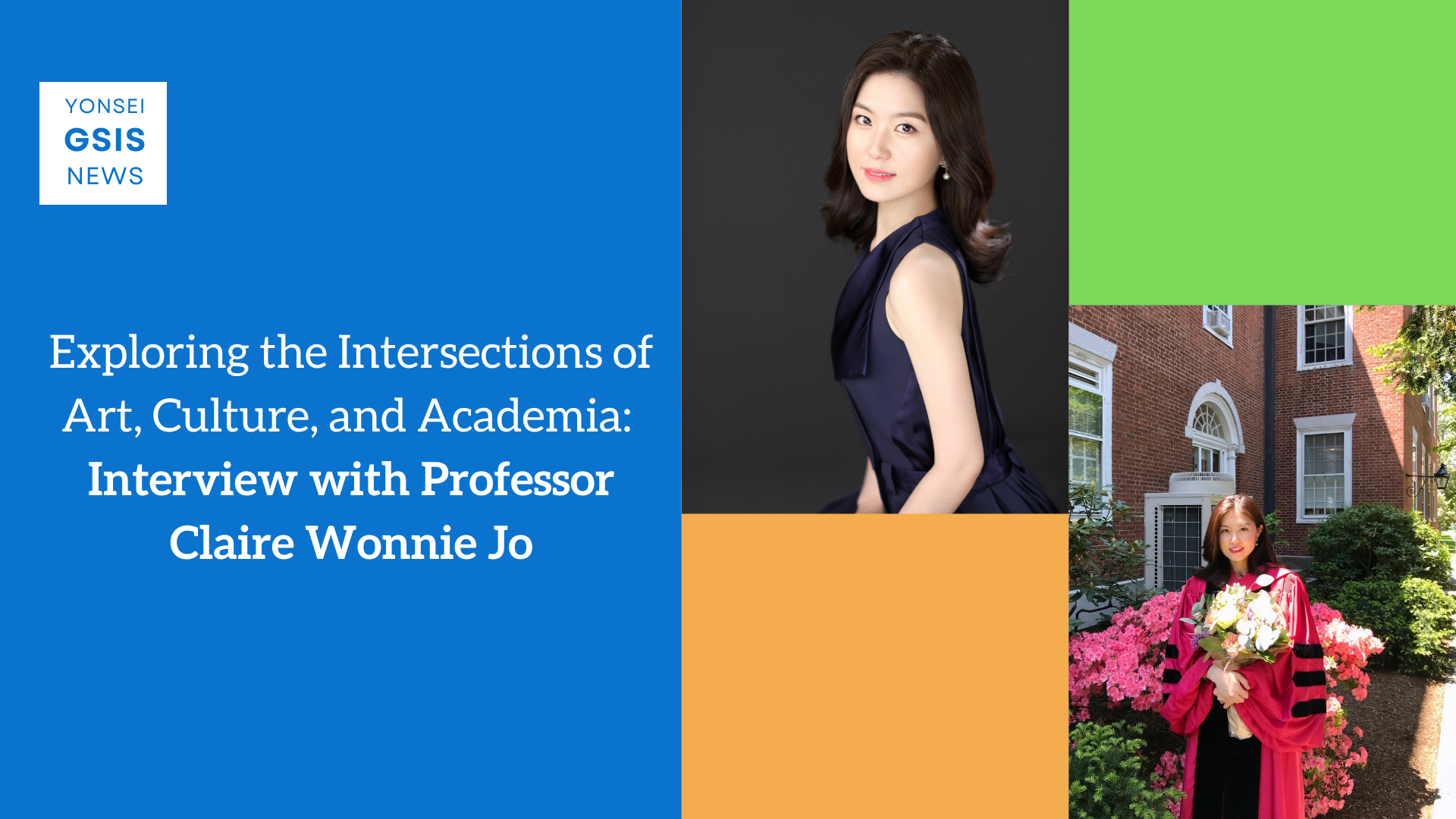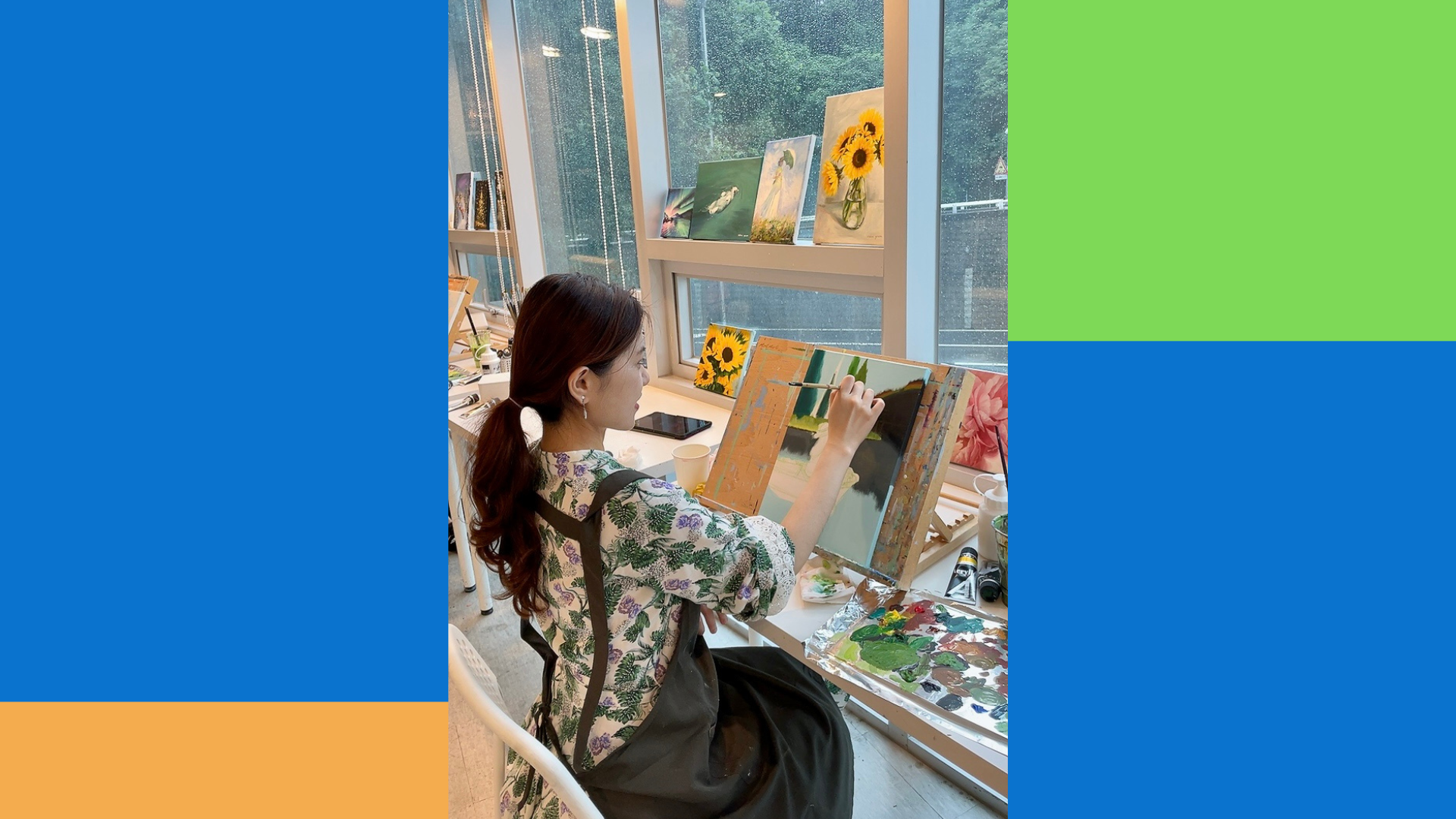- 제목
- [Newsletter] Exploring the Intersections of Art, Culture, and Academia: An Interview with Professor Claire Wonnie Jo
- 작성일
- 2024.05.21
- 작성자
- 국제학대학원
- 게시글 내용
-

Prof. Claire Wonnie Jo, graduating from the doctoral program at Harvard University.
By Alexander Rivera Gonzalez,
Editor in Chief, Yonsei GSIS Newsletter
Professor Claire Jo’s academic journey has been eclectic and interdisciplinary, weaving through diverse disciplines and continents. Initially trained as a professional cellist, her aspirations took a sharp turn following a wrist injury at 18, giving up her dream of becoming a concert cellist and leading her to contemplate careers in fashion or interior design.
Initially, she was offered scholarships to study at top art schools in the US, including the Dean’s Scholarship at the Parsons School of Design and the Rhode Island School of Design (RISD). However, following her parents’ advice, she was better suited to theoretical aspects of art, and after much deliberation between art history and law (she also received an offer from the University of Sydney Law School for a combined degree in law and commerce), but she decided to study art history, contemporary art theory, and linguistics at the University of Sydney. Her ambition was to become a curator at a major art museum/gallery or an art dealer at a major art auction house, such as Sotheby’s or Christie’s.
After briefly working as an assistant curator at her mom’s art gallery in Sydney, she decided to go to Harvard University, where she pursued a master’s and doctorate in Human Development and Education on a Frank Knox Memorial Fellowship (merit-based full scholarship and stipend for seven years).
At Harvard, she enrolled in courses across various areas, from cross-national and cross-cultural analysis to visual studies, intercultural communication, and developmental psychology, and even cross-registering at MIT to study bilingualism. There, she had the opportunity to interact and establish friendships with scholars across disciplines, from art history, film studies, design, architecture, education, linguistics, economics, finance, and law to international relations. Through this interdisciplinary learning and interactions at Harvard, she developed a highly flexible approach to research and teaching in the arts and cultural studies.
In this interview with the Yonsei GSIS newsletter, Professor Jo shares her vision of promoting Korean arts and culture internationally through a nuanced understanding of diverse dimensions.
-Thank you very much for accepting this interview. First, we want to know what sparked your interest in cross-cultural analysis and intercultural communication and how you see these fields evolving in today's globalized world.
-My pleasure! My interest in cross-cultural analysis and intercultural communication stems from a childhood immersed in diverse cultural experiences. Raised in both Korea and Australia, I had the privilege of witnessing the power of cultural exchange. One particular moment was during my mother's solo exhibition, where I had the opportunity to interact with directors of cultural foundations such as the Goethe-Institut and the British Council in Korea. Their roles in promoting international cultural exchange ignited my fascination with cultural understanding and diplomacy from a young age. I also recall attending an exhibition at my mother’s art gallery, sponsored by the Australian Embassy in Korea. The event featured textile works by Korean and Australian artists, highlighting the importance of intercultural communication in diplomacy.
Moving to Australia due to my mother’s work at the Australian National University was a very important moment in my life. Immersed in Canberra's diplomatic community, I was humbled to find myself among only four Korean students out of approximately 1300 girls from kindergarten to Grade 12. Growing up surrounded by children of diplomats, I embraced the opportunity to represent Korea and share my culture at the school’s multicultural events. I consider my music training to have provided invaluable insights into cultural differences in communication. Learning from cello teachers from Germany and Denmark and collaborating with pianists from China and Russia, I gained a deeper appreciation for cross-cultural interactions and honed my communication skills.
In today’s globalized world, where interactions among diverse cultures are more prevalent than ever, the importance of cross-cultural analysis and intercultural communication cannot be overstated. As globalization continues to connect people from different backgrounds, cultivating awareness of one’s own culture and understanding of others is essential for promoting collaboration and mutual understanding across various disciplines and fields.
-Your expertise also extends to contemporary Korean and international art. What drew you to this intersection of Korean and international art, and how do you incorporate it into your teaching and research?
-My journey into modern and contemporary international art spanned my undergraduate and graduate studies, where I immersed myself in courses ranging from Contemporary Australian Indigenous Art to Contemporary International Art and Biennales. Despite the lack of offerings in Korean art outside of Korea, my curiosity about my native land's artistic heritage persisted. Turning to Japanese art, which shares similarities with Korean art, provided a stepping stone for exploring these interests.
To deepen my understanding of modern and contemporary Korean art, I sought out courses and seminars at universities and art museums in Korea, supplementing my studies with extensive personal research. Drawing parallels between Korean and non-Korean art forms became a cornerstone of my research approach, fostering discussions that transcend cultural boundaries. In my teaching, I integrate diverse perspectives by encouraging students to compare Korean art with its counterparts from Europe, Australia, and Japan. For example, I have encouraged comparisons between the paintings of Dansaekhwa artist Park Seo-bo and American Minimalists (e.g., Cy Twombly and Agnes Martin) and between those of Yoo Youngkuk and Mark Rothko. Students gain a nuanced understanding of cultural influences on artistic expression by examining similarities and differences in artistic techniques and themes.
Moreover, as an art history major, I recognize the value of experiential learning in art history and contemporary art theory, which I learned through on-site classes at major art museums and galleries. Thus, I try to incorporate visits to major art museums into my classes, allowing students to analyze artworks in relation to their surrounding architecture. Recent visits to the Museum of Modern and Contemporary Art (MMCA) Seoul and the Dongdaemun Design Plaza (DDP) in my two classes provided enriching experiences that complemented classroom discussions.
-Transitioning to your role here at Yonsei GSIS, what motivated you to join our faculty?
-When I first learned about the opportunity to join the faculty at Yonsei GSIS, I was at a crossroads in my career, contemplating a return to the US for pursuits in contemporary art or art business. However, combining my interdisciplinary background in the arts with cross-cultural analysis to promote Korean arts and culture intrigued me incredibly. I was particularly impressed by Dean Lee and Associate Dean Jung's enthusiasm for Korean art and its expanding market during the job talk. Their shared vision of elevating various Korean arts and culture dimensions, including contemporary Korean art and design, impacted me. Joining Yonsei GSIS presents a unique opportunity for me to contribute to innovative programs in Korean cultural management and arts education. I am excited to collaborate with like-minded colleagues in advancing our collective mission of fostering greater appreciation and awareness of Korean arts and culture on both national and international scales.
-As a new professor at Yonsei GSIS, what contributions do you hope to make to the academic community?
-As a new professor at Yonsei GSIS, I am eager to leverage the institution's prestigious reputation and tradition in international studies to pioneer innovative initiatives in promoting Korean arts and culture globally. I envision creating a specialized program within GSIS dedicated to showcasing and facilitating active international cultural exchanges that can fill a gap in Yonsei's academic offerings and be a beacon for promoting cross-cultural understanding and appreciation. Additionally, I am eager to collaborate with experts from diverse disciplines and foster interdisciplinary dialogues that enrich our understanding of the role of arts and culture. Through strategic partnerships and initiatives, I hope to position Yonsei GSIS as a hub for interdisciplinary research and scholarship that contributes to advancing Korean arts and culture while enriching the academic community.
-What are your interests and hobbies beyond academia? How do they influence your approach to teaching and research?
-I like art, design, fashion, and music. I find inspiration in attending exhibitions and concerts, which fuel my creativity and passion for the arts. Additionally, I enjoy indulging in various hobbies, though balancing them with my academic responsibilities can be challenging. Among my hobbies, I have pursued private lessons or classes in ballet, pilates, studio art (painting), French, and golf. While my schedule at Yonsei GSIS limits the time I can devote to these activities, I plan to resume my pursuits, particularly ballet and French, in the near future. At some point, I would also love to pick up the cello and piano again (I have not played both instruments for a long time), and Japanese, and take lessons in swimming, horseback riding, and the harp so I can play both cello and harp parts in “Le Cygne (“The Swan”)” by Saint-Saëns.
-What advice do you have for students aspiring to pursue careers in Korean Studies?
-Networking is essential! Aspiring professionals in Korean Studies must cultivate a flexible mindset and actively seek opportunities for collaboration. I recommend you attend industry events, guest lectures, and social gatherings to connect with key figures. Additionally, consider pursuing internships, even short-term ones, to gain practical experience and expand your professional network. These opportunities can provide connections that may lead to future career opportunities. Finally, fluency in Korean is a significant asset for anyone seeking to work in Korea. While excellent academic qualifications from institutions like Yonsei GSIS are essential, proficiency in the local language can open doors to a wider range of opportunities and facilitate meaningful connections with local communities and organizations.
-Finally, could you share any upcoming projects or initiatives you are excited about in your research or special lectures within the Yonsei GSIS community?
-I plan to launch a research project at Yonsei GSIS to elevate the institution's profile locally and globally while promoting contemporary Korean art, design, and popular culture. This initiative will include the development of arts education programs that foster greater awareness of Korean arts and culture on the global stage. I look forward to sharing more information as the project progresses. In addition, I have organized a series of special lectures for the Yonsei GSIS community featuring key figures in contemporary Korean art, art business, and K-culture. I am committed to ensuring that these initiatives align with the mission and values of Yonsei GSIS and contribute to the institution's academic excellence and reputation as a leader in international studies.
 Professor Claire Wonnie Jo painting in an art studio in Seoul.
Professor Claire Wonnie Jo painting in an art studio in Seoul.

